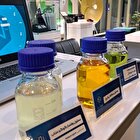Researchers Discover Unexpected New Form of Molecular Motion

Researchers at Johannes Gutenberg University Mainz (JGU), the Max Planck Institute for Polymer Research, and the University of Texas at Austin have discovered a previously unobserved form of molecular motion. When so-called “guest molecules”—molecules that reside within a host—enter droplets of DNA polymers, they do not spread randomly. Instead, they move through the droplets in a clearly defined frontal wave, the journal Nature Nanotechnology reported.
“This is an effect we did not expect at all,” said Weixiang Chen of the Department of Chemistry at JGU, who played a key role in the study.
The research offers important insights into how cells regulate signals. It may also lead to the development of intelligent biomaterials, novel membrane technologies, programmable drug delivery systems, and synthetic cells that replicate the complex organization of biological processes.
Molecules typically spread through liquids by simple diffusion. For example, when blue dye is added to a glass of water, it gradually disperses, creating soft, blurry color gradients. But the behavior of guest molecules in DNA droplets does not follow this pattern. “The molecules move in a structured and controlled manner that is contrary to the traditional models, and this takes the form of what appears to be a wave of molecules or a mobile boundary,” explains Professor Andreas Walther from JGU’s Department of Chemistry, who led the project.
The research team worked with droplets composed of thousands of individual DNA strands, also known as biomolecular condensates. A key advantage of these structures is that their properties can be finely tuned by adjusting the DNA sequences and environmental factors such as salt concentration. These synthetic droplets are similar to natural ones found in biological cells, which use condensates to organize complex biochemical processes without relying on membranes. “Our synthetic droplets thus represent an excellent model system with which we can simulate natural processes and come to better understand them,” emphasizes Chen.
The researchers introduced specially designed guest DNA strands into the droplets. These strands are able to recognize and bind to the internal structure of the droplets. The unusual motion observed—reported for the first time—is partly due to how the added DNA interacts with the host DNA, using a key-and-lock mechanism. This interaction reduces the density of the surrounding material and allows local regions to become more fluid and dynamic.
Chen adds: “The well-defined, highly concentrated front continues to move forward in a linear fashion over time, driven by chemical binding, material conversion, and programmable DNA interactions. Something that is completely new when it comes to soft matter.”
The findings are not only relevant to providing us with a better understanding of the physics of soft matter, but also to improving our knowledge of the chemical processes that occur in cells. “This might be one of the missing pieces of the puzzle that, once assembled, will reveal to us how cells regulate signals and organize processes on the molecular level,” states Walther. This would also be of interest when it comes to the treatment of neurodegenerative disorders in which proteins migrate from cell nuclei into the cytoplasm, forming condensates there. As these age, they transform from a dynamic to a more stable state and build the problematic fibrils. “It is quite conceivable that we may be able to find a way of influencing these aging processes with the aid of our new insights, so that, over the long term, an entirely new approach to the treatment of neurodegenerative diseases could emerge,” concludes Walther.
4155/v





















